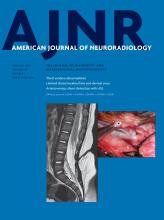Index by author
Pakpoor, J.
- Adult BrainYou have accessEmergency Department MRI Scanning of Patients with Multiple Sclerosis: Worthwhile or Wasteful?J. Pakpoor, D. Saylor, I. Izbudak, L. Liu, E.M. Mowry and D.M. YousemAmerican Journal of Neuroradiology January 2017, 38 (1) 12-17; DOI: https://doi.org/10.3174/ajnr.A4953
Palesch, Y.
- FELLOWS' JOURNAL CLUBNeurointerventionOpen AccessEndovascular Therapy of M2 Occlusion in IMS III: Role of M2 Segment Definition and Location on Clinical and Revascularization OutcomesT.A. Tomsick, J. Carrozzella, L. Foster, M.D. Hill, R. von Kummer, M. Goyal, A.M. Demchuk, P. Khatri, Y. Palesch, J.P. Broderick, S.D. Yeatts, D.S. Liebeskind and for the IMS III InvestigatorsAmerican Journal of Neuroradiology January 2017, 38 (1) 84-89; DOI: https://doi.org/10.3174/ajnr.A4979
The authors reviewed the impact of revascularization on clinical outcomes in 83 patients with M2 occlusions in the Interventional Management of Stroke III trial according to specific M1–M2 segment anatomic features. AnmRS 0–2 outcome was associated with reperfusion for M2 trunk (n = 9) or M2 division (n = 42) occlusions, but not for M2 branch occlusions (n = 28). Of the 83 participants with M2 occlusion who underwent endovascular therapy, 41.0% achieved mRS 0–2 at 90 days, including 46.6% with modified TICI 2–3 reperfusion compared with 26.1% with modified TICI 0–1 reperfusion. They conclude that mRS 0–2 at 90 days was dependent on reperfusion for M2 trunk but not for M2 branch occlusions in IMS III.
Paul, L.
- NeurointerventionYou have accessEmbolization of Intracranial Dural Arteriovenous Fistulas Using PHIL Liquid Embolic Agent in 26 Patients: A Multicenter StudyS. Lamin, H.S. Chew, S. Chavda, A. Thomas, M. Piano, L. Quilici, G. Pero, M. Holtmannspolter, M.E. Cronqvist, A. Casasco, L. Guimaraens, L. Paul, A. Gil Garcia, A. Aleu and R. ChapotAmerican Journal of Neuroradiology January 2017, 38 (1) 127-131; DOI: https://doi.org/10.3174/ajnr.A5037
Payabvash, S.
- Adult BrainYou have accessAcute Ischemic Stroke Infarct Topology: Association with Lesion Volume and Severity of Symptoms at Admission and DischargeS. Payabvash, S. Taleb, J.C. Benson and A.M. McKinneyAmerican Journal of Neuroradiology January 2017, 38 (1) 58-63; DOI: https://doi.org/10.3174/ajnr.A4970
Pero, G.
- NeurointerventionYou have accessEmbolization of Intracranial Dural Arteriovenous Fistulas Using PHIL Liquid Embolic Agent in 26 Patients: A Multicenter StudyS. Lamin, H.S. Chew, S. Chavda, A. Thomas, M. Piano, L. Quilici, G. Pero, M. Holtmannspolter, M.E. Cronqvist, A. Casasco, L. Guimaraens, L. Paul, A. Gil Garcia, A. Aleu and R. ChapotAmerican Journal of Neuroradiology January 2017, 38 (1) 127-131; DOI: https://doi.org/10.3174/ajnr.A5037
Peyton, C.
- FELLOWS' JOURNAL CLUBPediatric NeuroimagingOpen AccessWhite Matter Injury and General Movements in High-Risk Preterm InfantsC. Peyton, E. Yang, M.E. Msall, L. Adde, R. Støen, T. Fjørtoft, A.F. Bos, C. Einspieler, Y. Zhou, M.D. Schreiber, J.D. Marks and A. DrobyshevskyAmerican Journal of Neuroradiology January 2017, 38 (1) 162-169; DOI: https://doi.org/10.3174/ajnr.A4955
Cerebral palsy has been predicted by analysis of spontaneous movements in the infant termed “General Movement Assessment.” The authors evaluated the utility of General Movement Assessment in predicting adverse cognitive, language, and motor outcomes in very preterm infants and attempted to identify brain imaging markers associated with both adverse outcomes and aberrant general movements in 47 preterm infants using MRI volumetric analysis and DTI. Nine infants had aberrant general movements and were more likely to have adverse neurodevelopmental outcomes, compared with infants with normal movements. In infants with aberrant movements, Tract-Based Spatial Statistics analysis identified significantly lower fractional anisotropy in widespread WM tracts. They conclude that aberrant general movements at 10–15 weeks' postterm are associated with adverse neurodevelopmental outcomes and specific white matter microstructure abnormalities for cognitive, language, and motor delays.
Phillips, M.D.
- Adult BrainOpen AccessMeasuring Brain Tissue Integrity during 4 Years Using Diffusion Tensor ImagingD. Ontaneda, K. Sakaie, J. Lin, X.-F. Wang, M.J. Lowe, M.D. Phillips and R.J. FoxAmerican Journal of Neuroradiology January 2017, 38 (1) 31-38; DOI: https://doi.org/10.3174/ajnr.A4946
Piano, M.
- NeurointerventionYou have accessEmbolization of Intracranial Dural Arteriovenous Fistulas Using PHIL Liquid Embolic Agent in 26 Patients: A Multicenter StudyS. Lamin, H.S. Chew, S. Chavda, A. Thomas, M. Piano, L. Quilici, G. Pero, M. Holtmannspolter, M.E. Cronqvist, A. Casasco, L. Guimaraens, L. Paul, A. Gil Garcia, A. Aleu and R. ChapotAmerican Journal of Neuroradiology January 2017, 38 (1) 127-131; DOI: https://doi.org/10.3174/ajnr.A5037
Pijnenburg, M.
- Spine Imaging and Spine Image-Guided InterventionsOpen AccessAssociations between Measures of Structural Morphometry and Sensorimotor Performance in Individuals with Nonspecific Low Back PainK. Caeyenberghs, M. Pijnenburg, N. Goossens, L. Janssens and S. BrumagneAmerican Journal of Neuroradiology January 2017, 38 (1) 183-191; DOI: https://doi.org/10.3174/ajnr.A5020
Piotin, M.
- NeurointerventionYou have accessImpact of Modified TICI 3 versus Modified TICI 2b Reperfusion Score to Predict Good Outcome following Endovascular TherapyC. Dargazanli, A. Consoli, M. Barral, J. Labreuche, H. Redjem, G. Ciccio, S. Smajda, J.P. Desilles, G. Taylor, C. Preda, O. Coskun, G. Rodesch, M. Piotin, R. Blanc and B. LapergueAmerican Journal of Neuroradiology January 2017, 38 (1) 90-96; DOI: https://doi.org/10.3174/ajnr.A4968
- FELLOWS' JOURNAL CLUBAdult BrainYou have accessIntracranial Arteriovenous Shunting: Detection with Arterial Spin-Labeling and Susceptibility-Weighted Imaging CombinedJ. Hodel, X. Leclerc, E. Kalsoum, M. Zuber, R. Tamazyan, M.A. Benadjaoud, J.-P. Pruvo, M. Piotin, H. Baharvahdat, M. Zins and R. BlancAmerican Journal of Neuroradiology January 2017, 38 (1) 71-76; DOI: https://doi.org/10.3174/ajnr.A4961
Ninety-two consecutive patients with a known (n = 24) or suspected arteriovenous shunting (n = 68) underwent DSA and brain MR imaging, including arterial spin-labeling/SWI and conventional angiographic MR imaging. DSA showed arteriovenous shunting in 63 of the 92 patients. Interobserver agreement was excellent. In 5 patients, arterial spin-labeling/SWI correctly detected arteriovenous shunting, while the conventional angiographic MR imaging did not. The authors conclude that the combined use of arterial spin-labeling and SWI may be an alternative to contrast-enhanced MRA for the detection of intracranial arteriovenous shunting.








